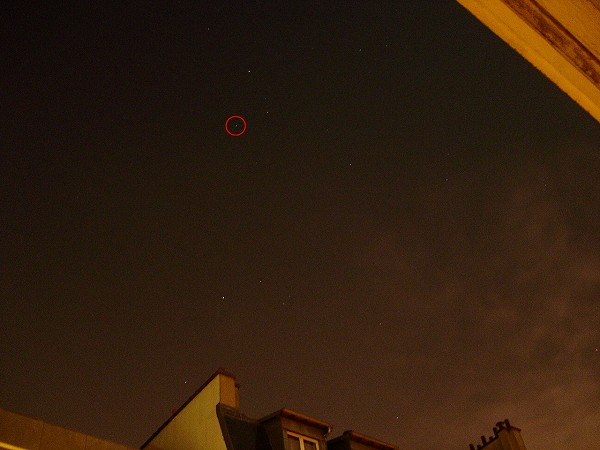
Image of comet 17P/Holmes by Valerie Desnoux the October 24, 2007. From Paris, 15eme arrondissement !
Comet 17P/Holmes outburst
Spectroscopic observations of comet 17P/Holmes
during a very impressive megaburst in brighness (from mag 16 to mag 2
the Oct. 23-24, 2007 !).
See UAI circular 8886.
Instrument : 0.28 m telescope (Celestron 11),
Lhires III spectrograph (1200 g/mm grating), Audine CCD camera (KAF-402ME chip).
For the Nov. 31 observation a LISA spectrograph is used.
Observatory
: Castanet-Tolosan (France) - suburban condition.
Observateur : C. Buil

Image
of comet 17P/Holmes by Valerie
Desnoux the October 24, 2007. From
Paris, 15eme arrondissement !
24 October 2007 observation
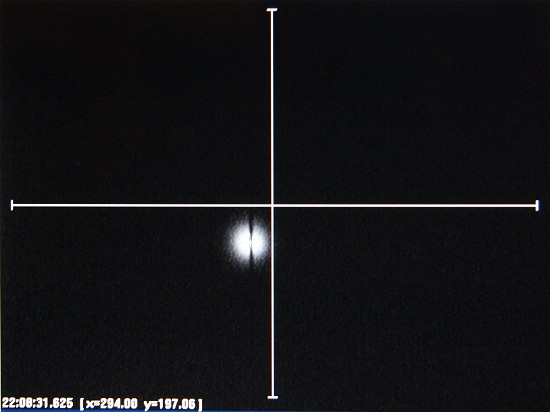
The
comet 17P/Holmes at the entrance slit of Lhires
III spectrograph (October 24, 2007 at V=2).

17P/Holmes
- Date: 24.892 / 10 / 2007 - C11 (D=0.28 m) + Lhires III 1200 g/mm (spectral
sampling 0.35 A/pixel)
Stack of 5 x 300 sec exposure - Mg I triplet region.
17P/Holmes
- Date: 24.892 / 10 2007 - Negative display - Mg I triplet region.
17P/Holmes
- Moon spectrum of the same spectral region and for the same nigth.
17P/Holmes
- Date: 24.892 / 10 2007 - After normalisation by the moon spectrum - Negative
display - Mg I triplet region.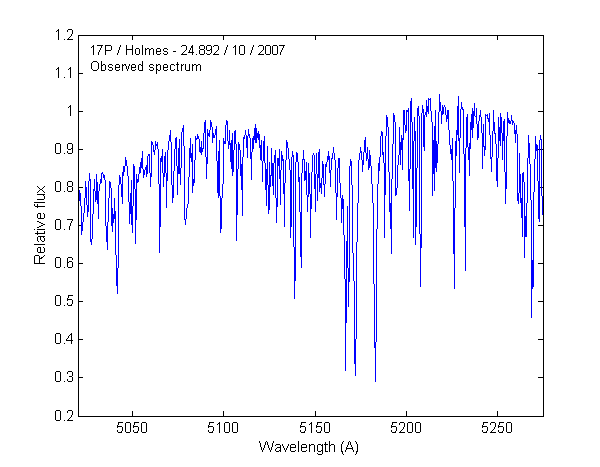
17P/Holmes
- Mg I region - Observed spectrum (C11 + Lhires III - R=6000).
|
|
|

17P/Holmes
- Date: 24.849 / 10 / 2007 - C11 (D=0.28 m) + Lhires III 1200 g/mm (spectral
sampling 0.35 A/pixel)
Stack of 4 x 300 sec exposure - Na I doublet region.
17P/Holmes
- Negative display - Na I doublet region.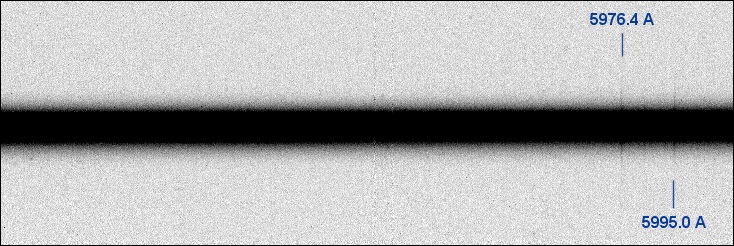
17P/Holmes
- Date: 24.849 / 10 2007 - After normalisation by the moon spectrum - Negative
display - Na I doublet region.

17P/Holmes
- Date: 24.867 / 10 / 2007 - C11 (D=0.28 m) + Lhires III 1200 g/mm (spectral
sampling 0.35 A/pixel)
Stack of 5 x 300 s exposure - 5730 A region.
17P/Holmes
- Negative view - 5730 A region.
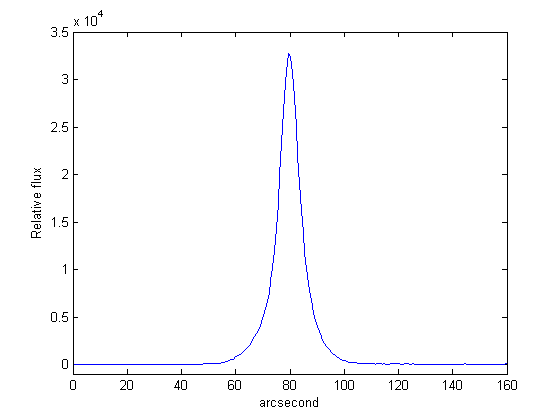
Photometric
profile of 17P/Holmes along the north-south direction from the Na I spectra
(binning along the spectral axis).
27 October 2007 observation

Images
of 17/P Holmes the 28 October 2007 1H35 UT. Celestron 11 + Canon ESO 40D camera.
Stack of 15 x15 sec. frames at 200ISO. Iris soft. processing. Upper views
and isophotal view are extracted from logarithm scaling.
Note the green-blue
extension - the result of a pure 516 nm C2 emission. The white balance
is carefully adjusted by
simultaneous observation of Moon. The color is
very close to "true" (for the eyes observation).

Some
Larson-Sekanina processing. Note the quasi annulus structure and presence
of jet. The covered field is 4.4' x 4.3'.
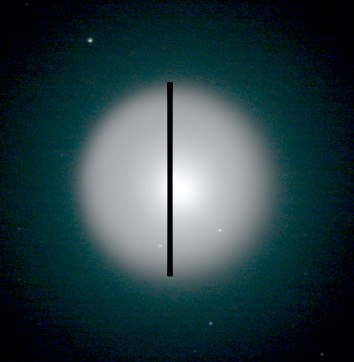
Position
of the slit the Oct. 27. North is up.
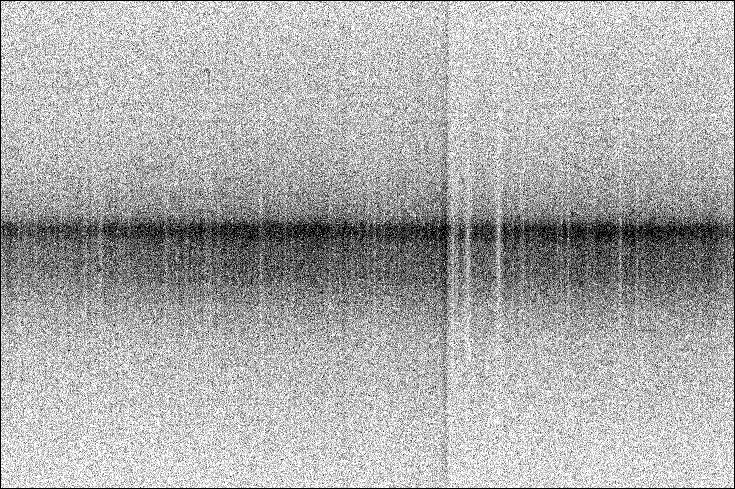
Spectrum
taken the 27.836 / 10 / 2007 of Mg I region. Composite of 14 x 300 sec elementary
spectra.
Relative to the Oct. 24 observation, the C2 emission near 516 nm
is very evident.
The gazes emission is clearly more extended then the dust
coma.
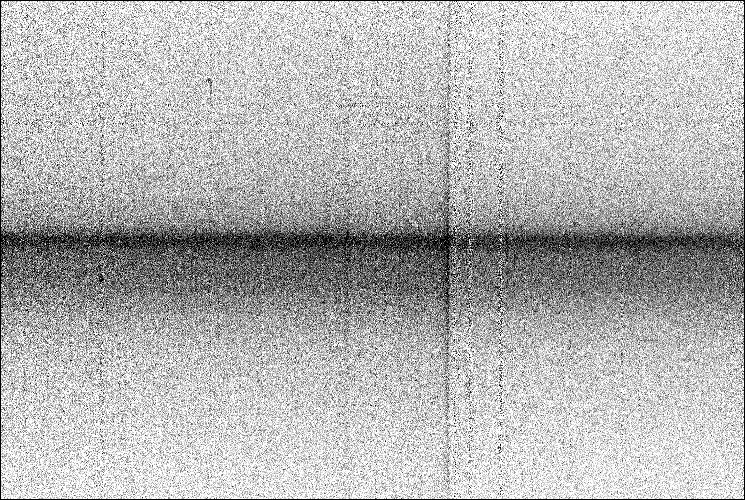
The
same spectrm after division by a lunar spectrum. The image is now representative
of the true reflectance and emission.
|
|
|
The dust reflectance dominate
the inner region, but the C2 band emission is now evident - it is the explanation
for the green color of outer part of the comet.
The faint feature at 513
nm is real (also visible the Oct. 24).

The
Na I region the 27.888 / 10 / 2007 (sum of 9 x 300 sec. exposure). Note the
absence of any gazes emission band.
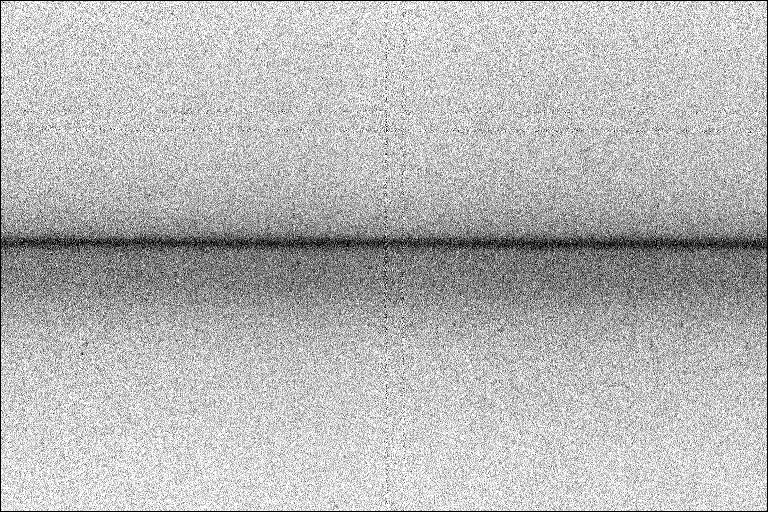
The
same spectrum of NaI region after normalization by a solar spectrum (Moon spectrum).

Date:
October 28, 2007 - 19H55 UT. Exposure: 39 x 15 sec. Celestron 11 + Canon EOS
40D
31 October 2007 observation
The LISA spectrograph is used in association with Digital SLR (Canon 40D standard & Canon 350D modified)
|
|
|
The setup. For details about
LISA spectrograph, click here.
Step by
step demo of the cometary spectra pipeline processing...

Nota:
the colors are "real" (i.e. restitued colors by a Digital SLR).
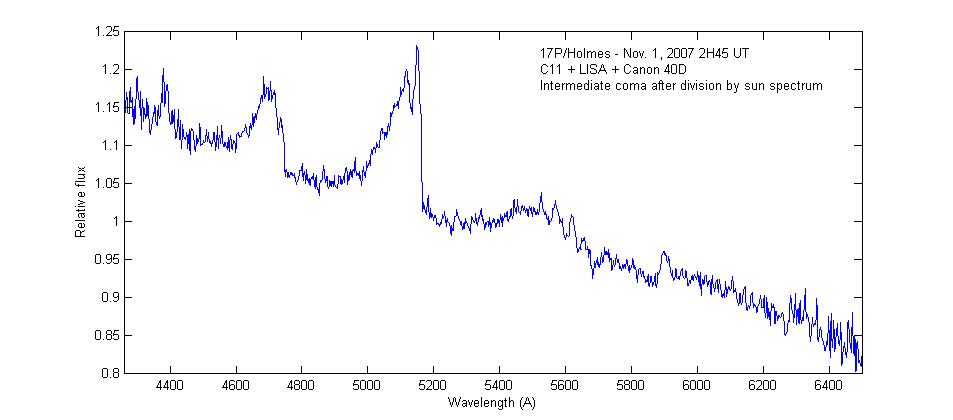
Date:
November 1st, 2007 - 2H45 UT. Exposure: 9 x 300 sec. C11 + LISA spectrograph
(grating 600 g/mm - R=1000) +
Canon EOS 350D modified (IR and UV cutoff
filter removed). The sky background is subtracted and the result is divided
by a Moon spectrum (i.e. Sun spectrum). The continuum is very equivalent
to reflective coefficient of comet material (dust + ice ?).
Note the blue
to red slope of the continnum. The C2 emission near 510 nm dominate this part
of the spectrum.

Date:
November 1st, 2007 - 2H45 UT. Exposure: 9 x 300 sec. C11 + LISA spectrograph
(grating 600 g/mm - R=1000) +
Canon EOS 350D modified (IR and UV cutoff
filter removed). Same has preceding spectrum but now a modeled continuum spectrum
is
substracted. Now, only emission gaz feature are visible.
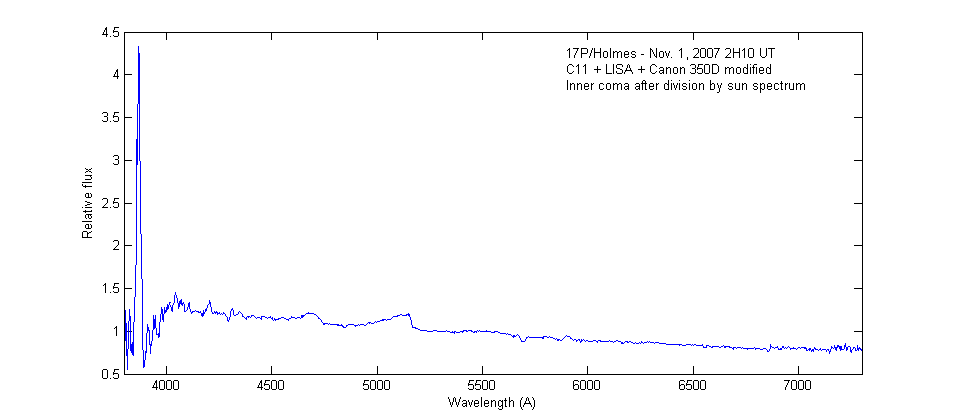
Date:
November 1st, 2007 - 2H10UT. Exposure: 8 x 300 sec. C11 + LISA spectrograph
(grating 600 g/mm - R=1000) +
Canon EOS 350D modified (internal IR and UV
cutoff filter removed). The sky background is subtracted and the result is divided
by a Moon spectrum (i.e. Sun spectrum). The document show a continuum
spectrum very equivalent to the reflective coefficient of comet
material
(dust or/and ice ?). The reflectivity is superior in the blue part of the spectrum. In superposition, molecular
and atomic gas emission is visible, but the dust-to-gas
ratio is very high
(i.e. low contribution from the molecular and atomic species). The CN line at
3883 A is prominent.
Colored
2D version of the LISA + 350D spectrum. The CN line is visible at the extreme
left of the image.
7 November 2007 observation
Canon 400mm f:5.6 L lens + Canon
EOS40D @ ISO 200 camera
Castanet-Tolosan Observatory (suburb.) - Stack of
20 x 180 sec. exposures
Date of mid exposure: 7 Nov. 2007 - 21H45 UT
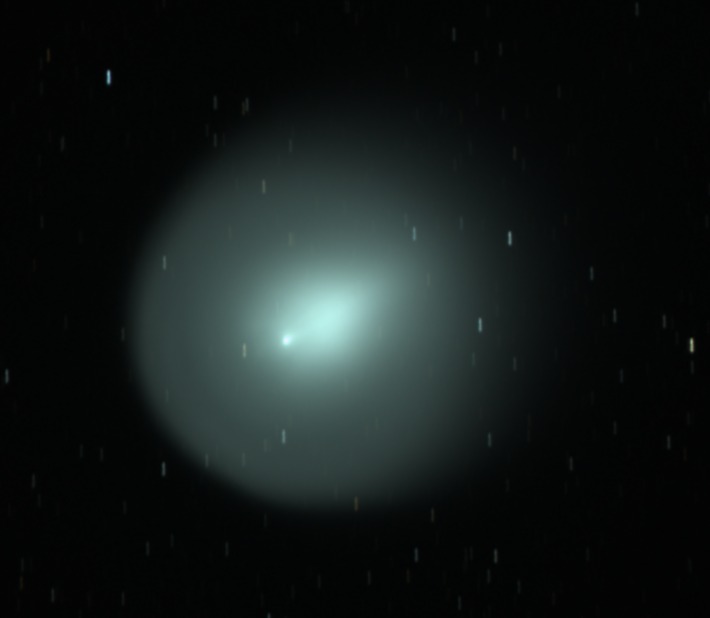
Standard
color view (crop of the original image at orgininal scale). North is left.
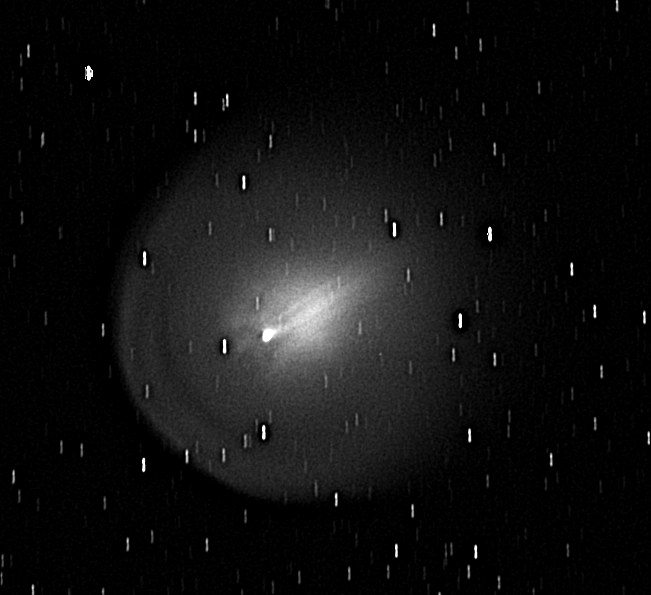
Unsharp
masking.

Isophotes
from a logarithm transform.

More
extended view (original reduced by a factor 2).
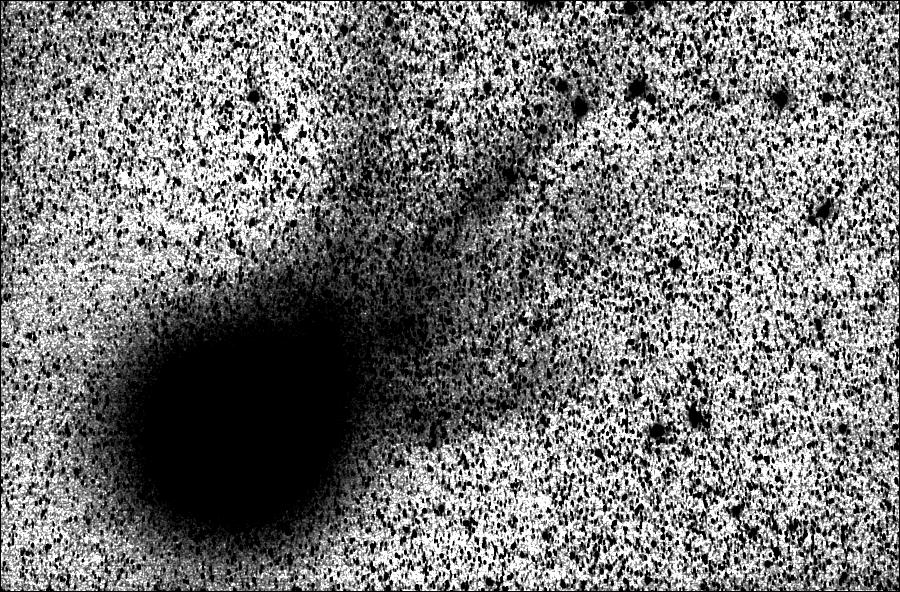
Global
view of the field (original scale reduced by a factor 4).
8 November 2007 observation
Canon 85mm 1.2 L lens stopped
at f/2 + Canon
EOS40D @ ISO 200 camera
Castanet-Tolosan Observatory (suburb.) - Exposure:
60 sec.
Date of mid exposure: 8 Nov. 2007 - 20H58 UT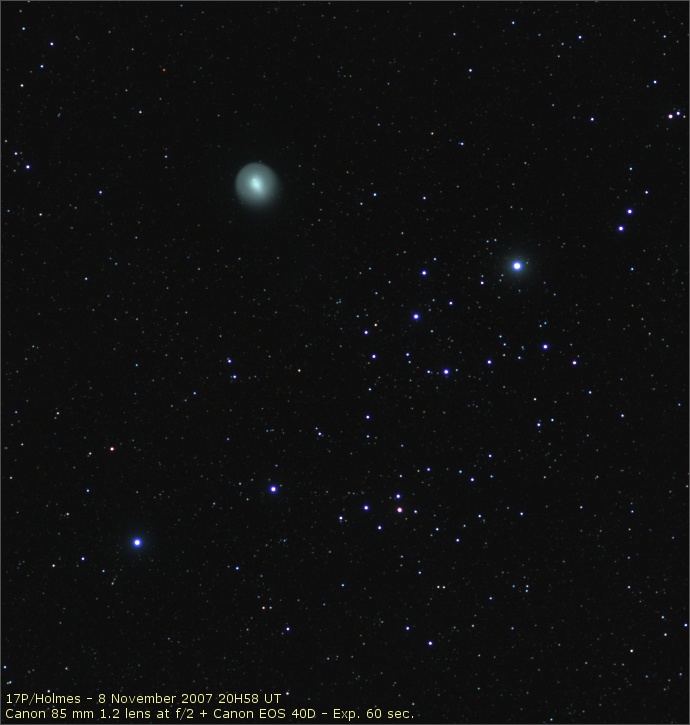
Scale
reduced by a factor relative to the original. North is up. The bright star is
Alpha Per.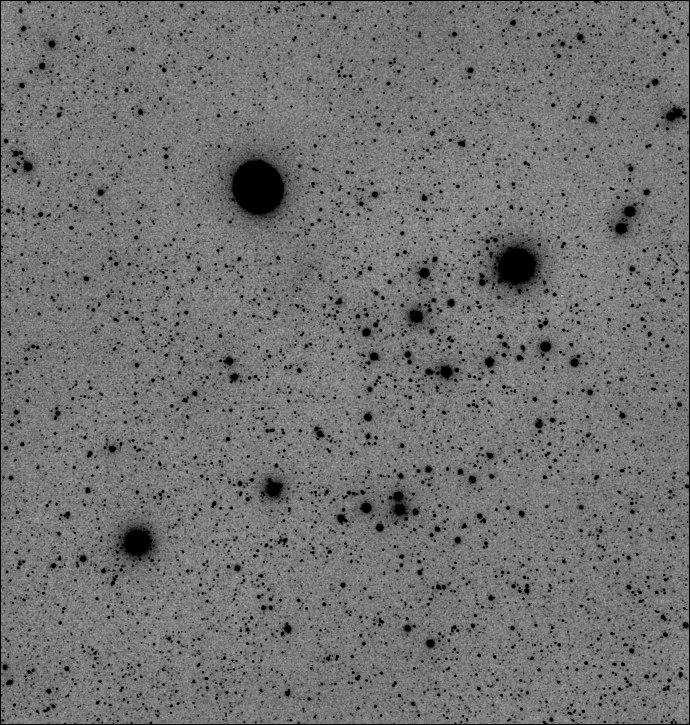
Negative
display.
9 November 2007 observation
Canon 135 mm f:2 L lens (used
at full aperture) + Canon
EOS40D @ ISO 200 camera
Castanet-Tolosan Observatory (suburb.) - Exposure:
22 x 120 sec.
Date of mid exposure: 10 Nov. 2007 - 02H07 UT
The
white balance is carefully from sunlight imaghes.

Negative
view of the blue channel.

A
global view of the field taken the 9 Nov. 2007 23H20 UT with a 85 mm f/1.2 lens
(22x 120 sec. exposure).
Click here for enlarge
the full frame.
10 November 2007 observation
Canon 135 mm f:2 L lens (used
at full aperture) + Canon
EOS40D @ ISO 200 camera
Castanet-Tolosan Observatory (suburb.) - Exposure:
35 x 320 sec.
Date of mid exposure: 10 Nov. 2007 - 22H07 UT 

17 November 2007 observation
Canon 200 mm f:2.8 L lens (used
at full aperture) + Canon
EOS40D @ ISO 200 camera
Castanet-Tolosan Observatory (suburb.) - Exposure:
5 x 300 sec.
Date of mid exposure: 17 Nov. 2007 - 00H50 UT
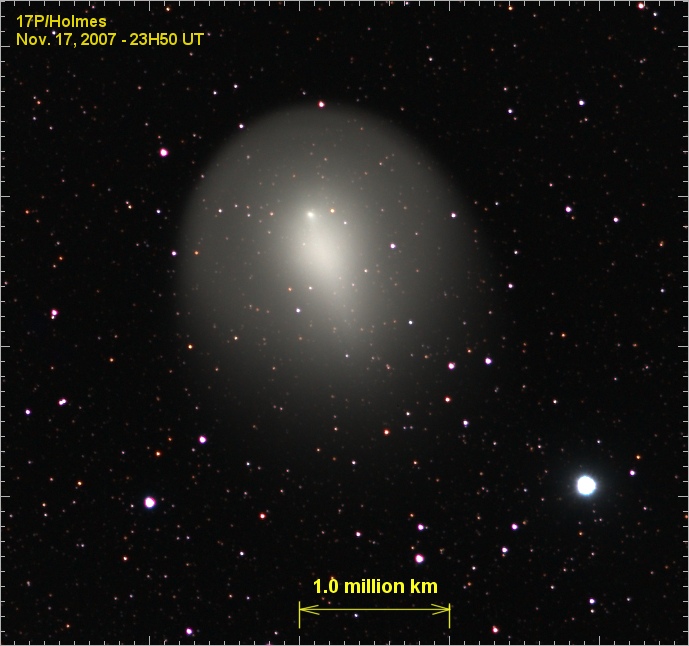
The
coma's diameter is larger than the diameter of Sun.
Negative
view.